Popular categories
Looking for a yarn?

100% Wool
from 11.00 RON /50g
The yarn cost is calculated from the pattern’s smallest size and the yarn’s cheapest product type. Looking for an even better price? You might find it on the DROPS Deals!
Outback
Knitted jumper in DROPS Snow or DROPS Wish. Piece is knitted top down with saddle shoulder. Size XS–XXL.
DROPS design: Pattern ee-702
Yarn group E or C + C
-------------------------------------------------------
SIZE:
XS - S - M - L - XL - XXL
MATERIALS:
DROPS SNOW from Garnstudio (belongs to yarn group E)
550-650-700-750-850-900 g colour 53, light grey
Or use:
DROPS WISH from Garnstudio (belongs to yarn group E)
400-450-500-550-650-650 g colour 03, light grey
KNITTING TENSION:
11 stitches in width and 15 rows vertically in stocking stitch = 10 x 10 cm.
NEEDLES:
DROPS DOUBLE POINTED NEEDLES SIZE 8 mm
DROPS CIRCULAR NEEDLE SIZE 8 mm : Length 40 and 80 cm for stocking stitch.
DROPS DOUBLE POINTED NEEDLES SIZE 7 mm
DROPS CIRCULAR NEEDLE SIZE 7 mm : Length 40 or 80 cm for rib.
Needle size is only a suggestion! If you have too many stitches on 10 cm switch to a larger needle size. If you have too few stitches on 10 cm switch to a smaller needle size.
-------------------------------------------------------
Alternative Yarn – See how to change yarns here
Yarn Groups A to F – Use the same pattern and change the yarn here
Yarn usage using an alternative yarn – Use our yarn converter here
-------------------------------------------------------

100% Wool
from 11.00 RON /50g
The yarn cost is calculated from the pattern’s smallest size and the yarn’s cheapest product type. Looking for an even better price? You might find it on the DROPS Deals!
- English (UK/cm), Romania
- Česky - not translated
- Dansk
- Deutsch
- Eesti keel - not translated
- English (UK/cm)
- English (US/in)
- Español
- Français
- Íslenska
- Italiano
- Magyar
- Nederlands
- Norsk
- Polski
- Português
- Suomi
- Svenska
- English (UK/cm), Bulgaria
- English (UK/cm), Croatia
- English (UK/cm), Greece
- English (UK/cm), Latvia
- English (UK/cm), Lithuania
- English (UK/cm), Slovenia
- Česky, Slovakia - not translated
Pattern instructions
EXPLANATION FOR THE PATTERN:
-------------------------------------------------------
PATTERN:
See diagram A.1. Choose diagram for your size.
INCREASE TIP-1:
BEFORE MARKER:
The new stitch will be twisted, leaning towards the right.
Use left needle to pick up strand between 2 stitches from the row below, pick up strand from behind and knit stitch in front loop.
AFTER MARKER:
The new stitch will be twisted, leaning towards the left.
Use left needle to pick up strand between 2 stitches from the row below, pick up strand from the front and knit stitch in back loop.
INCREASE TIP-2 (evenly):
To calculate how to increase evenly, use the total number of stitches on row (e.g. 104 stitches) and divide stitches by number of increases to be done (e.g. 20) = 5.2.
In this example increase by making 1 yarn over after approx. every 5th stitch. On next round work yarn over twisted
DECREASE TIP (applies to sleeves):
Decrease 1 stitch on each side of marker thread as follows: Work until 3 stitches remain before marker thread and knit 2 together, knit 2 (marker thread is between these stitches), slip 1 stitch knitwise, knit 1, pass slipped stitch over stitch worked.
CAST-OFF TIP:
To avoid a tight cast-off edge you may use a larger needle size. If this also is too tight, work a 1 yarn over after approx. every 4th stitch while casting off (cast off yarn overs as regular stitches).
-------------------------------------------------------
START THE PIECE HERE:
-------------------------------------------------------
JUMPER - SHORT OVERVIEW OF THE PIECE:
Work neck edge and yoke in the round on circular needle from mid back, top down.
Then divide the piece for body and sleeves. Work body in the round on circular needle. Work sleeves in the round, top down.
DOUBLE NECK EDGE:
Cast on 48-56-56-56-64-64 stitches on a short circular needle size 7 mm with Snow or Wish. Work rib (knit 2/purl 2) in the round for 13 cm. Insert a marker at beginning of round = approx. mid back. NOW MEASURE PIECE FROM HERE! Switch to circular needle size 8 mm.
YOKE:
Work next round as follows: Knit the first 8-8-8-8-8-8 stitches while increasing 0-1-1-2-2-2 stitches (= approx. half back piece), insert 1st marker here, work A.1 (choose diagram for correct size) over the next 10-10-10-10-14-14 stitches (= shoulder stitches), insert 2nd marker here, knit the next 14-18-18-18-18-18 stitches while increasing 0-2-2-4-4-4 stitches (= front piece), insert 3rd marker here, work A.1 over the next 10-10-10-10-14-14 stitches (= shoulder stitches), insert 4th marker here, knit over the last 6-10-10-10-10-10 stitches while increasing 0-1-1-2-2-2 stitches evenly (= approx. half back piece) = 48-60-60-64-72-72 stitches.
SADDLE SHOULDER INCREASE:
Knit over stitches on back and front piece and work pattern according to diagram A.1 over the 10-10-10-10-14-14 stitches for each shoulder. AT THE SAME TIME Increase 4 stitches on round as follows:
Increase BEFORE 1st and 3rd marker, and AFTER 2nd and 4th marker – read INCREASE TIP-1. There are only increases on back piece and front piece and number of shoulder stitches remains the same. Increase like this every round 16-17-18-19-21-23 times in total = 112-128-132-140-156-164 stitches. REMEMBER THE KNITTING TENSION!
SLEEVE INCREASE:
Knit over stitches on front piece and back piece, and work pattern after diagram A.1 over the 10-10-10-10-14-14 stitches on each shoulder. AT THE SAME TIME increase 4 stitches on the round as follows:
Increase AFTER 1st and 3rd marker, and BEFORE 2nd and 4th marker – remember INCREASE TIP-1. There are only increases on shoulder stitches and number of stitches on front piece and back piece remains the same.
Increase like this on every round 3-3-4-6-6-6 times in total and on every other round 8-8-8-8-8-9 times = 156-172-180-196-212-224 stitches.
Piece should now measure approx. 23-24-25-27-29-31 cm from marker thread and down mid back. If the piece is shorter than this, continue in stocking stitch and A.1 until correct measurements.
Now divide piece for body and sleeves. Work next round as follows:
Knit the first 25-26-27-29-31-33 stitches (= approx. half back piece), slip the next 30-32-34-38-42-44 stitches on a stitch holder for sleeve and cast on 6-6-8-8-8-8 new stitches on needle (= in the side under sleeve), knit the next 48-54-56-60-64-68 stitches, slip the next 30-32-34-38-42-44 stitches on a stitch holder for sleeve and cast on 6-6-8-8-8-8 new stitches on needle (= in the side under sleeve), knit the last 23-28-29-31-33-35 stitches. Then finish body and sleeves separately. NOW MEASURE PIECE FROM HERE!
BODY:
= 108-120-128-136-144-152 stitches. Work in stocking stitch in the round. When piece measures 20-21-22-22-21-21 cm from division, knit 1 round while increasing 16-20-20-20-24-24 stitches evenly - read INCREASE TIP-2= 124-140-148-156-168-176 stitches. Switch to circular needle size 7 mm. Work rib (knit 2/purl 2) in the round for 7 cm. Cast off with knit over knit and purl over purl - read CAST-OFF TIP. Jumper measures approx. 54-56-58-60-62-64 cm from marker after neck edge and down.
SLEEVES:
Slip the 30-32-34-38-42-44 stitches from stitch holder in one side of piece back on a short circular needle/double pointed needles size 8 mm , and pick in addition up 1 stitch in each of the new 6-6-8-8-8-8 stitches under sleeve = 36-38-42-46-50-52 stitches. Insert a marker thread in the middle of the new stitches under sleeve (= 3-3-4-4-4-4 new stitches on each side of marker thread). This is the beginning of round. Knit over knit and purl over purl. When sleeve measures 4 cm from division, decrease 1 stitch on each side of marker thread - read DECREASE TIP. Decrease like this every 5½-6½-4-3-2½-2½ cm 2-2-4-5-6-6 times in total = 32-34-34-36-38-40 stitches. Work until sleeve measures 38-37-37-35-35-34 cm from division. Now work 1 round in pattern as before while increasing 8-10-10-8-10-12 stitches evenly over stitches in stocking stitch = 40-44-44-44-48-52 stitches. Switch to double pointed needles size 7 mm. Work rib (= knit 2/purl 2) in the round - adjust so that rib fits the entire round, and to work rib as before over the 10-10-10-10-14-14 stitches (= shoulder stitches). When rib measures 7 cm, cast off with knit over knit and purl over purl - remember CAST-OFF TIP. Sleeve measures 45-44-44-42-42-41 cm in total from division. Work the other sleeve the same way.
ASSEMBLY:
Fold rib at the top of neck down on the inside of garment. Fasten rib to form a double neck edge. To avoid a tight neck edge and avoiding the edge to tip outwards, it is important to make the seam elastic.
Diagram

|
= knit |

|
= purl |

|
= saddle shoulder increase |

|
= sleeve increase |
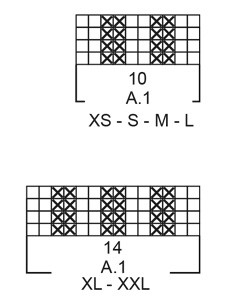

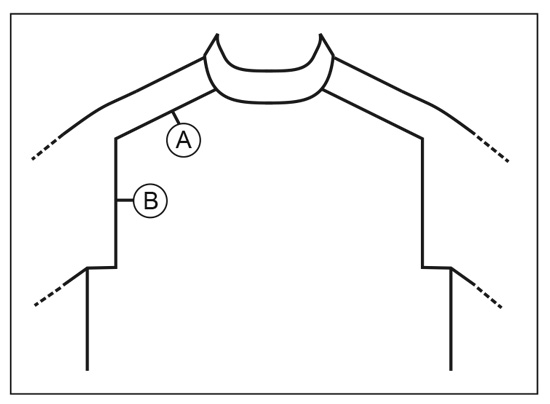
What can you do with our patterns? You can share DROPS patterns online, using the pattern original picture, materials, name and number. But you are NOT ALLOWED to reproduce the complete pattern digitally in any way. Yarn stores are welcome to use the DROPS pattern database to promote the sale of our assortment. You can print out our patterns, make as many copies as you’d like. The only thing we ask is that you don't make any changes / additions to the original printed document. And that the patterns according to the DROPS philosophy are given out to the consumers for free. Editorials that wish to publish our patterns in printed books or magazines can contact us for more information. The sale of garments based on DROPS patterns is permitted as long as they are sold as single items or per order. Further commercial use of the patterns is not permitted. It has to be clearly stated that the garment is made based on a design from DROPS DESIGN. The use of clothing labels of which DROPS DESIGN forms part is conditioned by the inclusion of the following text: “A DROPS DESIGN made by …..”. The use of DROPS photos for marketing purposes/sales is only permitted in connection with the use/sale of DROPS products. The photos may not be cut or edited and the logo should be clearly visible.
We reserve the right to withdraw the permission for use of our patterns at any time, notwithstanding the reason.
Each of our patterns has specific tutorial videos to help you.
These step-by-step tutorials might also help you:
Why is the knitting/crochet tension so important?
Knitting tension is what determines the final measurements of your work, and is usually measured per 10 x 10 cm. It is provided like so: number of stitches in width x number of rows in height - eg: 19 stitches x 26 rows = 10 x 10 cm.
The knitting tension is very individual; some people knit/crochet loosely while others work tightly. You adjust the knitting tension with the needle size, which is why the suggested needle size is only meant as a guide! You need to adjust this (up or down) to ensure that YOUR knitting tension matches the knitting tension provided in the pattern. If you work with a different knitting tension than provided you will have a different yarn consumption, and your work will have different measurements than what the pattern suggests.
The knitting tension also determines which yarns can replace each other. As long as you achieve the same knitting tension you can replace one yarn with another.
See DROPS lesson: How to measure your tension/gauge
See DROPS video: How to make a gauge tension swatch
How do I know how many balls of yarn I need?
The required amount of yarn is provided in grams, eg: 450 g. To calculate how many balls you’ll need you first need to know how many grams are in 1 ball (25g, 50g or 100g). This information is available if you click on the individual yarn quality on our pages. Divide the amount required with the amount of each ball. For example, if each ball is 50g (the most common amount), the calculation will be as follows: 450 / 50 = 9 balls.
Can I use a different yarn than what the pattern suggests?
The important thing when changing from one yarn to another is that the knitting/crochet tension remains the same. This is so that the measurements of the finished piece will be the same as on the sketch provided. It is easier to achieve the same knitting tension using yarns from the same yarn group. It is also possible to work with multiple strands of a thinner yarn to achieve the knitting tension of a thicker one. Please try our yarn converter. We recommend you to always work a test swatch.
Please NOTE: when changing yarn the garment might have a different look and feel to the garment in the photo, due to individual properties and qualities of each yarn.
See DROPS lesson: Can I use a different yarn than the one mentioned in the pattern?
What are the yarn groups?
All our yarns are categorised into yarn groups (from A to F) according to thickness and knitting tension – group A contains the thinnest yarns and group F the thickest. This makes it easier for you to find alternative yarns to our patterns, should you wish to switch yarn. All yarns within the same group have a similar knitting tension and can easily replace each other. However, different yarn qualities have different structures and properties which will give the finished work a unique look and feel.
How do I use the yarn calculator?
At the top of all our patterns you’ll find a link to our yarn calculator, which is a helpful tool should you wish to use a different yarn than suggested. By filling in the yarn quality you wish to replace, the amount (in your size) and number of strands, the calculator will present good alternative yarns with the same knitting tension. Additionally it will tell you how much you’ll require in the new qualities and whether you’ll need to work with multiple strands. Most skeins are 50g (some are 25g or 100g).
If the pattern is worked with multiple colours, every colour will have to be calculated separately. Similarly, if the pattern is worked with several strands of different yarns (for example 1 strand Alpaca and 1 strand Kid-Silk) you will have to find alternatives for each, individually.
Why do you show discontinued yarns in the patterns?
Since different yarns have different qualities and textures we have chosen to keep the original yarn in our patterns. However, you can easily find options among our available qualities by using our yarn calculator, or simply pick a yarn from the same yarn group.
It is possible that some retailers still have discontinued yarns in stock, or that someone has a few skeins at home that they would like to find patterns for.
The yarn calculator will provide both alternative yarn as well as required amount in the new quality.
What size should I knit?
If you think it's hard to decide what size to make, it can be a good idea to measure a garment you own already and like the size of. Then you can pick the size by comparing those measures with the ones available in the pattern's size chart.
You'll find the size chart at the bottom of the pattern.
See DROPS lesson: How to read size chart
Why do I get the wrong knitting tension with the suggested needle size?
The needle size provided in the pattern serves only as a guide, the important thing is to follow the knitting tension. And since knitting tension is very individual, you will have to adjust the needle size to ensure that YOUR tension is the same as in the pattern – maybe you’ll have to adjust 1, or even 2 needle sizes, up or down to achieve the correct tension. For this, we recommend that you work test swatches.
Should you work with a different knitting tension than the one provided, the measurements of the finished garment might deviate from the measurement sketch.
See DROPS lesson: How to measure your tension/gauge
See DROPS video: How to make a tension/gauge swatch
Why is the pattern worked top-down?
Working a garment top-down provides more flexibility and room for personal adjustment. For example it is easier to try the garment on while working, as well as making adjustments to length of yoke and shoulder caps.
The instructions are carefully explaining every step, in the correct order. Diagrams are adjusted to the knitting direction and are worked as usual.
How do I work according to a knitting diagram?
The diagram depicts all rows/rounds, and every stitch seen from the right side. It is read from bottom to top, from right to left. 1 square = 1 stitch.
When working back and forth, every other row is worked from the right side and every other row is worked from the wrong side. When working from the wrong side, the diagram will have to be worked reversed: from left to right, knit stitches are purled, purl stitches are knit etc.
When working in the round every round is worked from the right side and the diagram are worked from right to left on all rounds.
See DROPS lesson: How to read knitting diagrams
How do I work according to a crochet diagram?
The diagram depicts all rows/rounds, and every stitch seen from the right side. It is worked from bottom to top, from right to left.
When working back and forth every other row is worked from the right side: from right to left and every other row is worked from the wrong side: from left to right.
When working in the round, every row in the diagram are worked from the right side, from right to left.
When working a circular diagram you start in the middle and work your way outwards, counter clockwise, row by row.
The rows usually start with a given number of chain stitches (equivalent to the height of the following stitch), this will either be depicted in the diagram or explained in the pattern.
See DROPS lesson: How to read crochet diagrams
How do I work several diagrams simultaneously on the same row/round?
Instructions for working several diagrams after each other on the same row/round, will often be written like so: “work A.1, A.2, A.3 a total of 0-0-2-3-4 times". This means you work A.1 once, then A.2 is worked once, and A.3 is repeated (in width) the number of times provided for your size – in this case like so: S = 0 times, M = 0 times, L=2 times, XL= 3 times and XXL = 4 times.
The diagrams are worked as usual: begin with the first row in A.1, then work the first row in A.2 etc.
See DROPS lesson: How to read knitting diagrams
See DROPS lesson: How to read crochet diagrams
Why are the sleeves shorter in larger sizes?
The total width of the garment (from wrist-to-wrist) will be larger in the larger sizes, despite the actual sleeves being shorter. The larger sizes have longer sleeve caps and wider shoulders, so there will be a good fit in all sizes.
Where on the garment is the length measured?
The measurement sketch/schematic drawing provides information regarding the full length of the garment. If it’s a jumper or a jacket the length is measured from the highest point on the shoulder closest to the neckline, and straight down to the bottom of the garment. It is NOT measured from the tip of shoulder. Similarly, the length of yoke is measured from the highest point on the shoulder and down to where yoke is split into body and sleeves.
On a jacket measures are never taken along bands, unless specifically stated. Always measure inside band stitches when measuring the length.
See DROPS lesson: How to read a schematic drawing
What is a repeat?
Diagrams are often repeated on the round or in height. 1 repeat is the diagram the way it appears in the pattern. If it says to work 5 repeats of A.1 in the round, then you work A.1 a total of 5 times after/next to each other in the round. If it says to work 2 repeats of A.1 vertically/in height you work the entire diagram once, then begin again at the start and work the entire diagram one more time.
Why does the piece start with more chain stitches than it’s worked with?
Chain stitches are slightly narrower than other stitches and to avoid working the cast-on edge too tight, we simply chain more stitches to begin with. The stitch count will be adjusted on the following row to fit the pattern and measurement sketch.
Why increase before the rib edge when the piece is worked top-down?
The rib edge is more elastic and will contract slightly compared to, for example, stocking stitch. By increasing before the rib edge, you avoid a visible difference in width between the rib edge and the rest of the body.
Why increase in the cast-off edge?
It’s very easy to cast off too tightly, and by making yarn overs while casting off (and simultaneously casting these off) you avoid a too tight cast off edge.
See DROPS video: How to bind off with yarn overs (yo)
How do I increase/decrease on every 3rd and 4th row/round alternately?
To achieve an even increase (or decrease) you can increase on, for example: every 3rd and 4th row alternately, like so: work 2 rows and increase on the 3rd row, work 3 rows and increase on the 4th. Repeat this until the increase is complete.
See DROPS lesson: Increase or decrease 1 st on every 3rd and 4th row alternately
How can I work a jacket in the round instead of back and forth?
Should you prefer to work in the round instead of back and forth, you may of course adjust the pattern. You’ll need to add steeks mid-front (usually 5 stitches), and follow the instructions. When you would normally turn and work from the wrong side, simply work across the steek and continue in the round. At the end you’ll cut the piece open, pick up stitches to work bands, and cover the cut edges.
See DROPS video: How to knit steeks and cut open
Can I work a jumper back and forth instead of in the round?
Should you prefer to work back and forth instead of in the round, you may of course adjust the pattern so you work the pieces separately and then assemble them at the end. Divide the stitches for the body in 2, add 1 edge stitch in each side (for sewing) and work the front and back pieces separately.
See DROPS lesson: Can I adapt a pattern for circular needles into straight needles?
Why is the pattern slightly different than what I see in the photo?
Pattern repeats can vary slightly in the different sizes, in order to get the correct proportions. If you’re not working the exact same size as the garment in the photo, yours might deviate slightly. This has been carefully developed and adjusted so that the complete impression of the garment is the same in all sizes.
Make sure to follow instructions and diagrams for your size!
How do I make a women’s size garment into a men’s size one?
If you have found a pattern you like which is available in women’s size it’s not very difficult to convert it to men’s size. The biggest difference will be the length of sleeves and body. Start working on the women size that you think would fit across the chest. The additional length will be worked right before you cast off for the armhole/sleeve cap. If the pattern is worked top-down you can add the length right after the armhole or before the first decrease on sleeve.
Regarding additional yarn amount, this will depend on how much length you add, but it is better with a skein too many than too few.
How do I prevent a hairy garment from shedding?
All yarns will have excess fibres (from production) that might come off as lint or shedding. Brushed yarns (ie hairier yarns) have more of these loose, excess fibres, causing more shedding.
Shedding also depends on what is worn under or over the garment, and whether this pulls at the yarn fibres. It’s therefore not possible to guarantee that there will be no shedding
Below are some tips on how to get the best result when working with hairier yarns:
1. When the garment is finished (before you wash it) shake it vigorously so the looser hairs come off. NOTE: do NOT use a lint roller, brush or any method that pulls at the yarn.
2. Place the garment in a plastic bag and put it in your freezer - the temperature will cause the fibres to become less attached to each other, and excess fibres will come off easier.
3. Leave in the freezer for a few hours before taking it out and shaking it again.
4. Wash the garment according to the instructions on the yarn label.
Why does my garment pill?
Pilling is a natural process that happens to even the most exclusive of fibers. It's a natural sign of wear and tear that is hard to avoid, and that is most visible in high friction areas of your garment like a sweater's arms and cuffs.
You can make your garment look as new by removing the pilling, using a fabric comb or a pill/lint remover.
In the meantime, you can read the questions and answers that others have left to this pattern or join the DROPS Workshop on Facebook to get help from fellow knitters/crocheters!
You might also like...
Outback |
|||||||||||||
 |
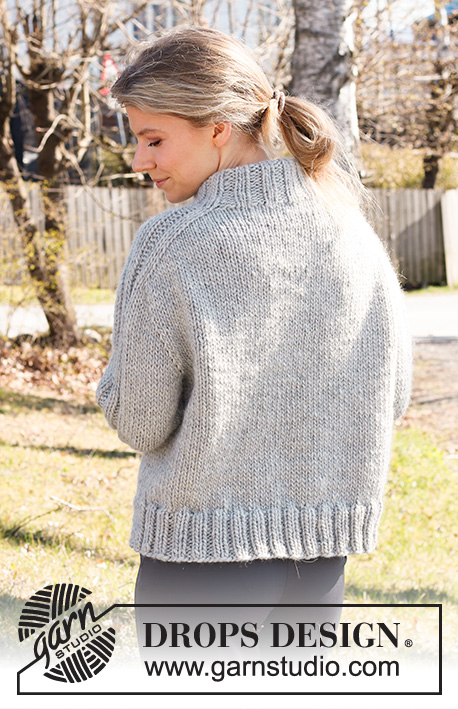 |
||||||||||||
Knitted jumper in DROPS Snow or DROPS Wish. Piece is knitted top down with saddle shoulder. Size XS–XXL.
DROPS 217-23 |
|||||||||||||
|
------------------------------------------------------- EXPLANATION FOR THE PATTERN: ------------------------------------------------------- PATTERN: See diagram A.1. Choose diagram for your size. INCREASE TIP-1: BEFORE MARKER: The new stitch will be twisted, leaning towards the right. Use left needle to pick up strand between 2 stitches from the row below, pick up strand from behind and knit stitch in front loop. AFTER MARKER: The new stitch will be twisted, leaning towards the left. Use left needle to pick up strand between 2 stitches from the row below, pick up strand from the front and knit stitch in back loop. INCREASE TIP-2 (evenly): To calculate how to increase evenly, use the total number of stitches on row (e.g. 104 stitches) and divide stitches by number of increases to be done (e.g. 20) = 5.2. In this example increase by making 1 yarn over after approx. every 5th stitch. On next round work yarn over twisted DECREASE TIP (applies to sleeves): Decrease 1 stitch on each side of marker thread as follows: Work until 3 stitches remain before marker thread and knit 2 together, knit 2 (marker thread is between these stitches), slip 1 stitch knitwise, knit 1, pass slipped stitch over stitch worked. CAST-OFF TIP: To avoid a tight cast-off edge you may use a larger needle size. If this also is too tight, work a 1 yarn over after approx. every 4th stitch while casting off (cast off yarn overs as regular stitches). ------------------------------------------------------- START THE PIECE HERE: ------------------------------------------------------- JUMPER - SHORT OVERVIEW OF THE PIECE: Work neck edge and yoke in the round on circular needle from mid back, top down. Then divide the piece for body and sleeves. Work body in the round on circular needle. Work sleeves in the round, top down. DOUBLE NECK EDGE: Cast on 48-56-56-56-64-64 stitches on a short circular needle size 7 mm with Snow or Wish. Work rib (knit 2/purl 2) in the round for 13 cm. Insert a marker at beginning of round = approx. mid back. NOW MEASURE PIECE FROM HERE! Switch to circular needle size 8 mm. YOKE: Work next round as follows: Knit the first 8-8-8-8-8-8 stitches while increasing 0-1-1-2-2-2 stitches (= approx. half back piece), insert 1st marker here, work A.1 (choose diagram for correct size) over the next 10-10-10-10-14-14 stitches (= shoulder stitches), insert 2nd marker here, knit the next 14-18-18-18-18-18 stitches while increasing 0-2-2-4-4-4 stitches (= front piece), insert 3rd marker here, work A.1 over the next 10-10-10-10-14-14 stitches (= shoulder stitches), insert 4th marker here, knit over the last 6-10-10-10-10-10 stitches while increasing 0-1-1-2-2-2 stitches evenly (= approx. half back piece) = 48-60-60-64-72-72 stitches. SADDLE SHOULDER INCREASE: Knit over stitches on back and front piece and work pattern according to diagram A.1 over the 10-10-10-10-14-14 stitches for each shoulder. AT THE SAME TIME Increase 4 stitches on round as follows: Increase BEFORE 1st and 3rd marker, and AFTER 2nd and 4th marker – read INCREASE TIP-1. There are only increases on back piece and front piece and number of shoulder stitches remains the same. Increase like this every round 16-17-18-19-21-23 times in total = 112-128-132-140-156-164 stitches. REMEMBER THE KNITTING TENSION! SLEEVE INCREASE: Knit over stitches on front piece and back piece, and work pattern after diagram A.1 over the 10-10-10-10-14-14 stitches on each shoulder. AT THE SAME TIME increase 4 stitches on the round as follows: Increase AFTER 1st and 3rd marker, and BEFORE 2nd and 4th marker – remember INCREASE TIP-1. There are only increases on shoulder stitches and number of stitches on front piece and back piece remains the same. Increase like this on every round 3-3-4-6-6-6 times in total and on every other round 8-8-8-8-8-9 times = 156-172-180-196-212-224 stitches. Piece should now measure approx. 23-24-25-27-29-31 cm from marker thread and down mid back. If the piece is shorter than this, continue in stocking stitch and A.1 until correct measurements. Now divide piece for body and sleeves. Work next round as follows: Knit the first 25-26-27-29-31-33 stitches (= approx. half back piece), slip the next 30-32-34-38-42-44 stitches on a stitch holder for sleeve and cast on 6-6-8-8-8-8 new stitches on needle (= in the side under sleeve), knit the next 48-54-56-60-64-68 stitches, slip the next 30-32-34-38-42-44 stitches on a stitch holder for sleeve and cast on 6-6-8-8-8-8 new stitches on needle (= in the side under sleeve), knit the last 23-28-29-31-33-35 stitches. Then finish body and sleeves separately. NOW MEASURE PIECE FROM HERE! BODY: = 108-120-128-136-144-152 stitches. Work in stocking stitch in the round. When piece measures 20-21-22-22-21-21 cm from division, knit 1 round while increasing 16-20-20-20-24-24 stitches evenly - read INCREASE TIP-2= 124-140-148-156-168-176 stitches. Switch to circular needle size 7 mm. Work rib (knit 2/purl 2) in the round for 7 cm. Cast off with knit over knit and purl over purl - read CAST-OFF TIP. Jumper measures approx. 54-56-58-60-62-64 cm from marker after neck edge and down. SLEEVES: Slip the 30-32-34-38-42-44 stitches from stitch holder in one side of piece back on a short circular needle/double pointed needles size 8 mm , and pick in addition up 1 stitch in each of the new 6-6-8-8-8-8 stitches under sleeve = 36-38-42-46-50-52 stitches. Insert a marker thread in the middle of the new stitches under sleeve (= 3-3-4-4-4-4 new stitches on each side of marker thread). This is the beginning of round. Knit over knit and purl over purl. When sleeve measures 4 cm from division, decrease 1 stitch on each side of marker thread - read DECREASE TIP. Decrease like this every 5½-6½-4-3-2½-2½ cm 2-2-4-5-6-6 times in total = 32-34-34-36-38-40 stitches. Work until sleeve measures 38-37-37-35-35-34 cm from division. Now work 1 round in pattern as before while increasing 8-10-10-8-10-12 stitches evenly over stitches in stocking stitch = 40-44-44-44-48-52 stitches. Switch to double pointed needles size 7 mm. Work rib (= knit 2/purl 2) in the round - adjust so that rib fits the entire round, and to work rib as before over the 10-10-10-10-14-14 stitches (= shoulder stitches). When rib measures 7 cm, cast off with knit over knit and purl over purl - remember CAST-OFF TIP. Sleeve measures 45-44-44-42-42-41 cm in total from division. Work the other sleeve the same way. ASSEMBLY: Fold rib at the top of neck down on the inside of garment. Fasten rib to form a double neck edge. To avoid a tight neck edge and avoiding the edge to tip outwards, it is important to make the seam elastic. |
|||||||||||||
Diagram explanations |
|||||||||||||
|
|||||||||||||

|
|||||||||||||

|
|||||||||||||

|
|||||||||||||
|
Have you made this or any other of our designs? Tag your pictures in social media with #dropsdesign so we can see them! Do you need help with this pattern?You'll find tutorial videos, a Comments/Questions area and more by visiting the pattern on garnstudio.com. © 1982-2024 DROPS Design A/S. We reserve all rights. This document, including all its sub-sections, has copyrights. Read more about what you can do with our patterns at the bottom of each pattern on our site. |
|||||||||||||
With over 40 years in knitting and crochet design, DROPS Design offers one of the most extensive collections of free patterns on the internet - translated to 17 languages. As of today we count 304 catalogues and 11422 patterns - 11422 of which are translated into English (UK/cm).
We work hard to bring you the best knitting and crochet have to offer, inspiration and advice as well as great quality yarns at incredible prices! Would you like to use our patterns for other than personal use? You can read what you are allowed to do in the Copyright text at the bottom of all our patterns. Happy crafting!









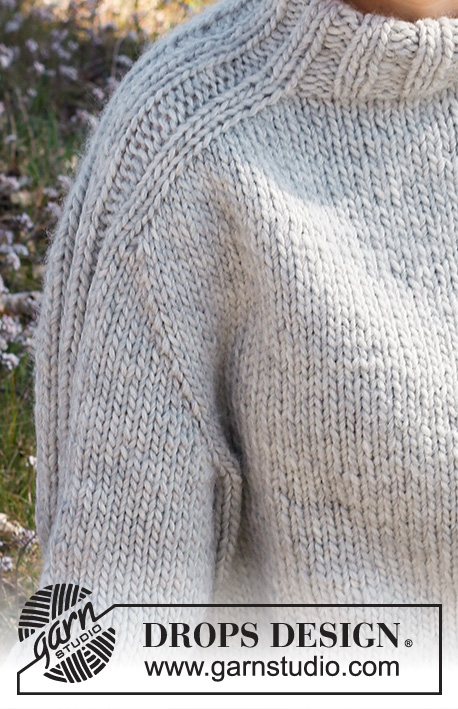


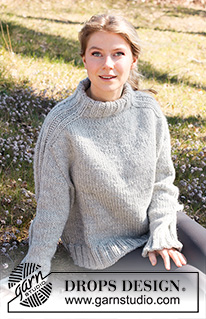

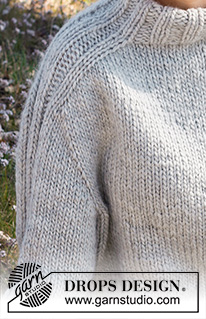




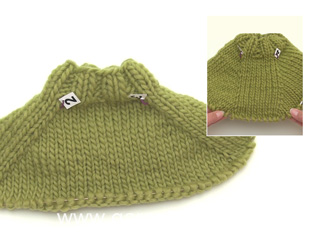
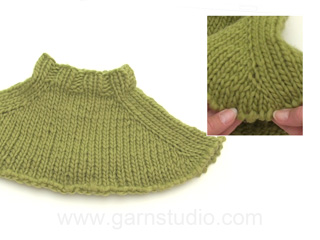
















































Comments / Questions (23)
Hei! Nå har jeg prøvd meg tre ganger, men det bare feiler. Hvordan kan jeg øke på denne måten må samme sted i hver omgang? Når jeg har kommet omgangen rundt og skal øke før merket igjen så «mangler» den tråden mellom maskene som jeg skal øke i.. Forsøkte å legge inn en omgang uten økninger mellom hver omgang med økninger, men det fungerte ikke. Hvordan gjør man økningen på hver omgang? Videoen stopper etter bare én omgang.
20.10.2022 - 14:14DROPS Design answered:
Hei Heidi, Det må være en tråd mellom de 2 maskene du skal øke i (ellers hadde de ikke hengt sammen) som du da plukker opp og strikker i som forklart under øketips-1. God fornøyelse!
21.10.2022 - 06:57Hej Drops. Der står under udtagning ved ærmer, "tag ud således på hver omgang totalt 3-3-4-6-6-6 gange og på hver 2.omgang 8-8-8-8-8-9 gange = 156-172-180-196-212-224 masker." hvordan tager jeg 8 masker ud på hver 2. omgang, når man kun kan tage 4 masker ud ved ærmerne (alt før og efter maskemarkør)?
14.09.2022 - 21:17DROPS Design answered:
Hei Emma. Du skal ikke øke med 8 masker, men 8 ganger på hver 2. omgang. Så først skal du øke på hver omgang totalt 3-3-4-6-6-6 ganger og deretter på hver 2.omgang 8-8-8-8-8-9 ganger = 156-172-180-196-212-224 masker. mvh DROPS Design
19.09.2022 - 09:03Bonjour pourriez-vous me dire à quoi servent les aiguilles double pointe demandées dans les fournitures Merci beaucoup
08.01.2022 - 08:26DROPS Design answered:
Bonjour Claudia, tout à fait, on utilise les aiguilles doubles pointes pour tricoter les manches. Vous pouvez également utiliser simplement une aiguille circulaire de 80 cm de chaque taille et la technique dite du magic loop. Bon tricot!
10.01.2022 - 07:44IK heb een vraag over de mouwmeerderingen: Meerder zo op iedere naald 3-3-4-6-6-6 keer in totaal en in iedere tweede naald 8-8-8-8-8-9 keer = 156-172-180-196-212-224 steken. Ik snap de 4 keer meerderen per naald, maar ik snap de 8 keer meerderen niet.
13.10.2021 - 12:56DROPS Design answered:
Dag Esther,
Je meerdert eerst op iedere naald en dit doe je 4 keer in totaal. Als dat klaar is ga je verder met de mouw en meerder je om de naald, dus de ene naald wel en de andere naald niet en dit doe je in totaal 8 keer.
15.10.2021 - 17:55Könnte ich diese Anleitung auch in deutsch bekommen? Besten Dank
23.05.2021 - 22:47DROPS Design answered:
Liebe Frau Kuhnert, ja sicher, alle unsere Anleitungen sind auch in Deutsch erhältlick; klicken Sie auf das drop-down Menu unter das Foto um die Sprache zu ändern. Viel Spaß beim stricken!
25.05.2021 - 08:04Buona sera Sto lavorando questo maglione e sono agli aumenti dello sprone( 1dietro e 2 davanti per la mia taglia).Potreste darmi un consiglio su come è meglio farli? Grazie
27.04.2021 - 18:43DROPS Design answered:
Buonasera, se non espressamente indicato, può utilizzare la tecnica che preferisce per gli aumenti, anche semplicemente lavorando 2 maglie in 1. Buon lavoro!
27.04.2021 - 19:50Hei, Jeg forstår ikke ermeøkningen. Det står at økningen skal være ETTER 1. og 3. merke og FØR 2. og 4. merke. (Motsatt på sadeløkning) Skal man øke rett Etter og FØR A01 slik at de to siste rettmaskene ikke er med i ermene?
23.04.2021 - 11:33DROPS Design answered:
Hei Elisabeth. Du øker rett etter merke 1 og 3 og rett før merke 2 og 4. Diagrammet strikkes som før (rett over rett og vrang over vrang). Du vil da strikke 1 maske mer før diagrammet og 1 maske mer etter diagrammet, etter hver gang det er økt. mvh DROPS design
03.05.2021 - 11:15Model Outback Model ee-702 - Mystisk - There are only increases on back piece and front piece, the number of shoulder stitches remains the same. Der tages kun ud på bagstykket og forstykket og antal skuldermasker forbliver det samme. There are only increases on back piece and front piece, the number of shoulder stitches remains the same. Der tages nu kun ud på ærmerne og antal masker på bagstykket og forstykket forbliver det samme. Vh Pia
03.02.2021 - 16:23Hej Der står ved udtagning sadelskulder: Der tages ud ETTER 1. og 3.mærke, og FØR 2. og 4.mærke og så længere nede ved udtagning ærmer i opskiften står det omvendte. Jeg forstår ikke hvordan man kan tale om efter og før, når man tager ud i en maske imellem to masker? Vh Pia
03.02.2021 - 08:55DROPS Design answered:
Hej Pia, under udtagning sadelskulder skriver vi: Der tages ud FØR 1. og 3.mærke, og EFTER 2. og 4.mærke – læs UDTAGNINGSTIPS-1. Men når du kommer længere i opskriften og tager ud til ærmer, så bliver det omvendt. Vi beskriver altså hvordan man tager ud før et mærke og efter et mærke. God fornøjelse!
03.02.2021 - 15:25Hej Drops. Hvor ser jeg hvilken størrelse jeg skal strikke? Hv.h Pia
01.02.2021 - 14:18DROPS Design answered:
Hei Pia. Denne genseren er strikket i 6 forskjellige størrelser (XS - S - M - L - XL - XXL). Du finner målene på målskissene helt nederst i oppskriften. God Fornøyelse!
01.02.2021 - 14:23